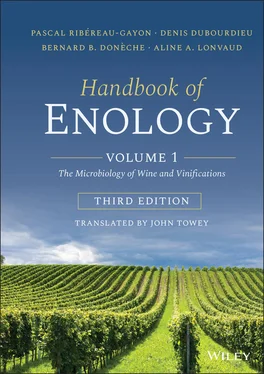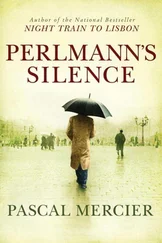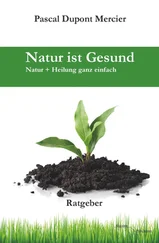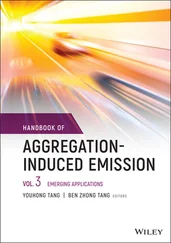The current book, which is the seventh French edition (third in English) of the Handbook of Enology , updates and enriches the knowledge found in the two‐volume edition that first appeared 20 years ago. Subsequent editions were printed in 2004 and then in 2012. As Émile Peynaud said in Le Vin et les Jours , “…enology is at the service of wine, it is a science in movement, advancing both in its research and applications…” As an applied science, it is irrigated by knowledge from the fundamental sciences (chemistry, biochemistry, microbiology, bioengineering, psychophysics, cognitive psychology, etc.) and nourished by empirical observations. The approach used in the Handbook of Enology is thus still the same. It is about providing practitioners, winemakers, technicians, and enology students with solid knowledge and the most recent research results. This knowledge can be used to contribute to a better definition of the quality of grapes and wine, a greater understanding of chemical and microbiological parameters, with the aim of ensuring satisfactory fermentations and predicting the evolution of wines, and better mastery of wine stabilization processes. As a result, the purpose of this publication is to guide readers in their thought processes with a view to preserving and optimizing the identity and taste of wine and its aging potential. In other words, this publication was meant, as the late Professor Denis Dubourdieu wrote, to help “…obtain original products that are sufficiently complex, fine, and appreciated by modern consumers…,” in a context where grape ripeness characteristics are evolving and greater attention is being placed on chemical additives.
The outline of this edition of the Handbook of Enology does not differ from the previous ones. Some of the chapters have been significantly reworked in light of recent research, while others have been changed only slightly or not at all. This is a collective work; it is the fruit of efforts by the researchers and professors of the Enology Research Unit at the Institut des Sciences de la Vigne et du Vin (ISVV), who provided their expertise to update this Volume 1:
Patricia Ballestra, Associate Professor, IUT Périgueux, Université de Bordeaux, researcher in the Enology Research Unit, ISVV, Université de Bordeaux (Volume 1, Chapter 5), regarding spoilage microorganisms related to mousiness.
Philippe Darriet, Director of the Enology Research Unit, Université de Bordeaux (Volume 1, Chapters 10and 13), regarding the biochemistry of aromas during grape ripening and overripening in the presence of Botrytis cinerea, special winemaking types.
Marguerite Dols‐Laffargue, Professor, ENSCBP, researcher in the Enology Research Unit, ISVV, Université de Bordeaux (Volume 1, Chapter 5), regarding sugar metabolism in lactic acid bacteria.
Laurence Geny, Professor, ISVV, Université de Bordeaux, researcher in the Enology Research Unit (Volume 1, Chapter 10), regarding the biochemistry of grapes and their maturation.
Aline A. Lonvaud, Professor Emeritus, ISVV, Université de Bordeaux, researcher in the Enology Research Unit (Volume 1, Chapters 1, 4– 7), regarding the microbiology of yeasts and bacteria in wine.
Patrick Lucas, Professor, ISVV, Deputy Director of the Enology Research Unit, Université de Bordeaux, researcher in the Enology Research Unit (Volume 1, Chapter 4), regarding the microbiology of bacteria in wine.
Axel Marchal, Professor, ISVV, Université de Bordeaux, researcher in the Enology Research Unit (Volume 1, Chapter 12), regarding red winemaking and the evolution of sensory aspects during the aging of wines.
Isabelle Masneuf‐Pomarede, Professor, Bordeaux Sciences Agro, researcher in the Enology Research Unit, ISVV, Université de Bordeaux (Volume 1, Chapter 1), regarding yeast cytology, ecology, and taxonomy.
Cécile Thibon, research engineer, INRAE, Bordeaux Sciences Agro, researcher in the Enology Research Unit, ISVV, Université de Bordeaux (Volume 1, Chapter 10), regarding the biochemistry of aromas during grape ripening and overripening in the presence of B. cinerea, varietal aromas.
The following persons also participated in writing the sixth French edition of Volume 1:
Marina Bely, Associate Professor HDR, ISVV, Université de Bordeaux, researcher in the Enology Research Unit (Volume 1, Chapters 1– 3), regarding the microbiology of yeasts.
Bernard B. Donèche, Professor, ISVV, Université de Bordeaux, former director of the training department at ISVCV (Volume 1, Chapter 10), regarding the biochemistry of grapes and their maturation.
Pierre‐Louis Teissedre, Professor, ISVV, Université de Bordeaux (Volume 1, Chapters 8, 9, and 12), regarding sulfur dioxide and complementary products, red winemaking.
PREFACE TO THE SECOND EDITION
The two‐volume Enology Handbook was published simultaneously in Spanish, French, and Italian in 1999 and has been reprinted several times. The Handbook has apparently been popular with students as an educational reference book, as well as with winemakers, as a source of practical solutions to their specific technical problems and scientific explanations of the phenomena involved.
It was felt appropriate at this stage to prepare an updated, reviewed, corrected version, including the latest enological knowledge, to reflect the many new research findings in this very active field. The outline and design of both volumes remain the same. Some chapters have changed relatively little as the authors decided there had not been any significant new developments, while others have been modified much more extensively, either to clarify and improve the text or, more usually, to include new research findings and their practical applications. Entirely new sections have been inserted in some chapters.
We have made every effort to maintain the same approach as we did in the first edition, reflecting the ethos of enology research in Bordeaux. We use indisputable scientific evidence in microbiology, biochemistry, and chemistry to explain the details of mechanisms involved in grape ripening, fermentations and other winemaking operations, aging, and stabilization. The aim is to help winemakers achieve greater control over the various stages in winemaking and choose the solution best suited to each situation. Quite remarkably, this scientific approach, most intensively applied in making the finest wines, has resulted in an enhanced capacity to bring out the full quality and character of individual terroirs. Scientific winemaking has not resulted in standardization or leveling of quality. On the contrary, by making it possible to correct defects and eliminate technical imperfections, it has revealed the specific qualities of the grapes harvested in different vineyards, directly related to the variety and terroir, more than ever before.
Interest in wine in recent decades has gone beyond considerations of mere quality and taken on a truly cultural dimension. This has led some people to promote the use of a variety of techniques that do not necessarily represent significant progress in winemaking. Some of these are simply modified forms of processes that have been known for many years. Others do not have a sufficiently reliable scientific interpretation, nor are their applications clearly defined. In this Handbook, we have only included rigorously tested techniques, clearly specifying the optimum conditions for their utilization.
As in the previous edition, we deliberately omitted three significant aspects of enology: wine analysis, tasting, and winery engineering. In view of their importance, these topics will each be covered in separate publications.
The authors would like to take the opportunity of the publication of this new edition of Volume 1 to thank all those who have contributed to updating this work:
Читать дальше












